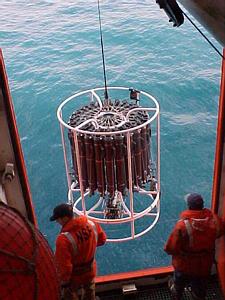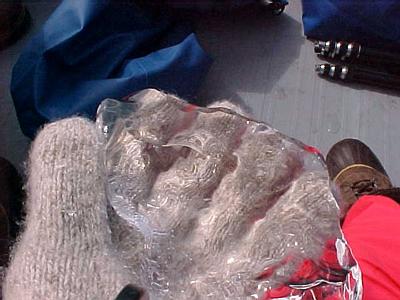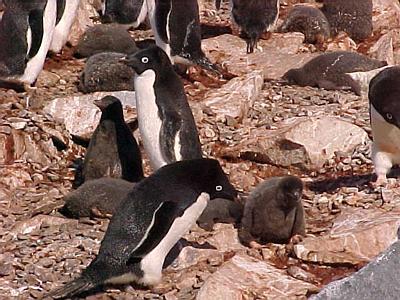9 January, 2000
Well it is going on 1:00am and I am going to get this journal entry out if
it kills me. I have had a glorious day! I spent half the day on the
ship. I went with them to one of their sampling stations close by. The
media crew from US News and World Report went as well. Also, a fellow from
International Wildlife was aboard. As we left the dock 2 Palmer residents
JUMPED IN THE OCEAN! They did this for amusement and the only way they
can get away with it is they run and get in the hot tub and heat their
body temperature back up! Anyway, I was interested in the science that
goes on at each station. We couldn't have asked for better weather.
Sunny, about 45 degrees F or so, and no wind! Everyone was on deck
soaking it up! The first test was the PRR (Profiling Relectance
Radiometer) This measures the upwelling and downwelling light in the
visible and ultraviolet (UV) range of the solar spectrum. The
phytoplankton folks then deployed a long cone shaped net with a bottle
attached to the bottom This is a phytoplankton net. The mesh of this net
is incredibly small...about 32 microns small! This net is drug and hauled
in to analyze the microscopic plant and animals caught. Then they
deployed the CTD....this device is an impressive apparatus about 7 feet
high and 5 feet in diameter (my estimate). It specifically tests for
conductivity, temperature, and depth. The data collected is combined to
calculate water column density necessary to describe water mass (similar
to air mass) and dynamics of ice formation as well as heat exchange at the
ocean-atmosphere interface. Also attached is the PAR (Photosynthetically
Available Radiation) sensor that measures visible radiation from 400 to
700 nm. There are 24-12 liter collection bottles, called Niskin bottles,
that circle the framework (called a rosette). Each bottle is cabled to
trigger shut at certain depths. Once the bottle snaps shut...Wha La! You
have collected 12 liters of ocean water. There is huge door that opens on
the side of the ship that allows the CTD to be wenched out over the water.
The CTD is guided to the right spot by two guys harnessed to a safety belt
to keep them from accidently slipping out of the ship! Everyone likes to
watch this deployment. It is just cool! Then the biosonics team deployed
a sonar off the starboard side of the ship. Their instrument was attached
to a framework that looks like a shark! It "swims" along side of the ship
sending out a signal that bounces back and is acoustically picked up. The
target organism they are searching for is krill. Lots of them baby! When
a patch of blue shows up on the computer screen it tells the scientists
there is a dense population of krill. Then they deployed the zooplankton
net. This is a 1 meter square net that is deployed to 300 meters. The
first net tow for these folks yielded very little. A few krill, fish
larvae, and interesting snails! Next they deploy a 2 meter square krill
net. It is deployed 125 meters. Not much krill were pulled out at this
station. These tests and more are repeated at each station the ship stops
at. A GPS is used to hit the correct location. It requires a lot of
organization and several commmitted people to pull off this amount of data
gathering. Maria Vernet is the chief scientist on this cruise and she
very successfully orchestrated impressive scientific research. I must say
that I am very impressed with her ability to get folks to work unashamedly
for 20 hours straight!
Well that was my morning! About 2:00pm a zodiac came to the ship to pick
me and the media guys up. We went and visited neighboring islands and saw
some of the most breathtaking glaciers, mountainscapes, and icebergs you
can imagine. I told people that I don't have the language to adequately
tell this story! It is simply beyond words. It seems every new turn we
made there was something more spectacular than before! We saw a beautiful
crabeater seal basking in the sun on a chunk of ice. He nodded to us and
continued his nap. We saw penguins galore! Swimming penguins....(I guess
they swim in a pod). They are very fast swimmers and can change direction
on a dime. We boated up to a floe where about 6 Adelie penguins were
gathered! We saw several bird nesting sites too. Beautiful cormorants
were nesting on rocks edges of Cormorant Island. There are more bird
species here than I imagined. We walked up Torgersen Island. This is a
big hang out for Adelie penguins. Thousands actually! I will be working
with Bill Fraser at these rookeries. He has been studying these penquins
for 20 some odd years! I will be collecting some artifacts from
Antarctica for a traveling "ice chest" that schools can use. I saw a
penquin skeleton that I will ask Bill about. It would make a great
addition to the chest. Anyway, I digressed, at the rookery we walked
among the birds and their chicks making sure to not disturb them in any
way. The chicks are very fuzzy and very cute! What struck me was they
are absolutely not afraid of us or bothered by our presence. This is
because they are protected by the Antarctic Treaty and therefore are not
familiar with humans bothering them!. All wildlife is
protected...seriously protected. We also saw several leopard seals.
These fellow are very intelligent, sleak animals. Very aggressive too.
They have been known to bite at a zodiac! Their only predator is an Orca.
We visit one spot called Dead Elephant Seal Point. Photographers got out
and took great pictures of the zodiac making a pass through the water.
Their story will come out sometime in February. Who knows, I may be in
it! Right place and the right time, eh! Well folks I need to wind this
down because it is very late and I will be up early.
If you are sending mail to me at mwallace@socorro.k12.tx.us TRY NOT TO.
The reason is I can only access it when the satellite is passing over. It
makes its first pass between 11pm and 4am.....too late for me to do mail
consistently...and its second pass is between 10am and 4pm. This is the
time when I am usually out and about. Anyway, email me at:
wallacmi@palmer.usap.nsf.gov
I look forward to hearing from you. For those of you who have written,
keep it up! I love sharing this wonderful experience with you. Until
tomorrow!
-Mimi

The CTD being deployed from the ship.

A group of Adelie penguins floating along on an ice floe.

This ice is called "bar ice" because it is used on station in drinks. There is no salt present.

A crabeater seal lounging in the sun on a floating ice barge.

As we pulled away from the dock, I tried to get a picture of these two fellows jumping in the freezing water!

Penguin rookery at Torgersen Island.
Contact the TEA in the field at
.
If you cannot connect through your browser, copy the
TEA's e-mail address in the "To:" line of
your favorite e-mail package.
|
